Taylor D.A. Introduction to marine engineering
Подождите немного. Документ загружается.

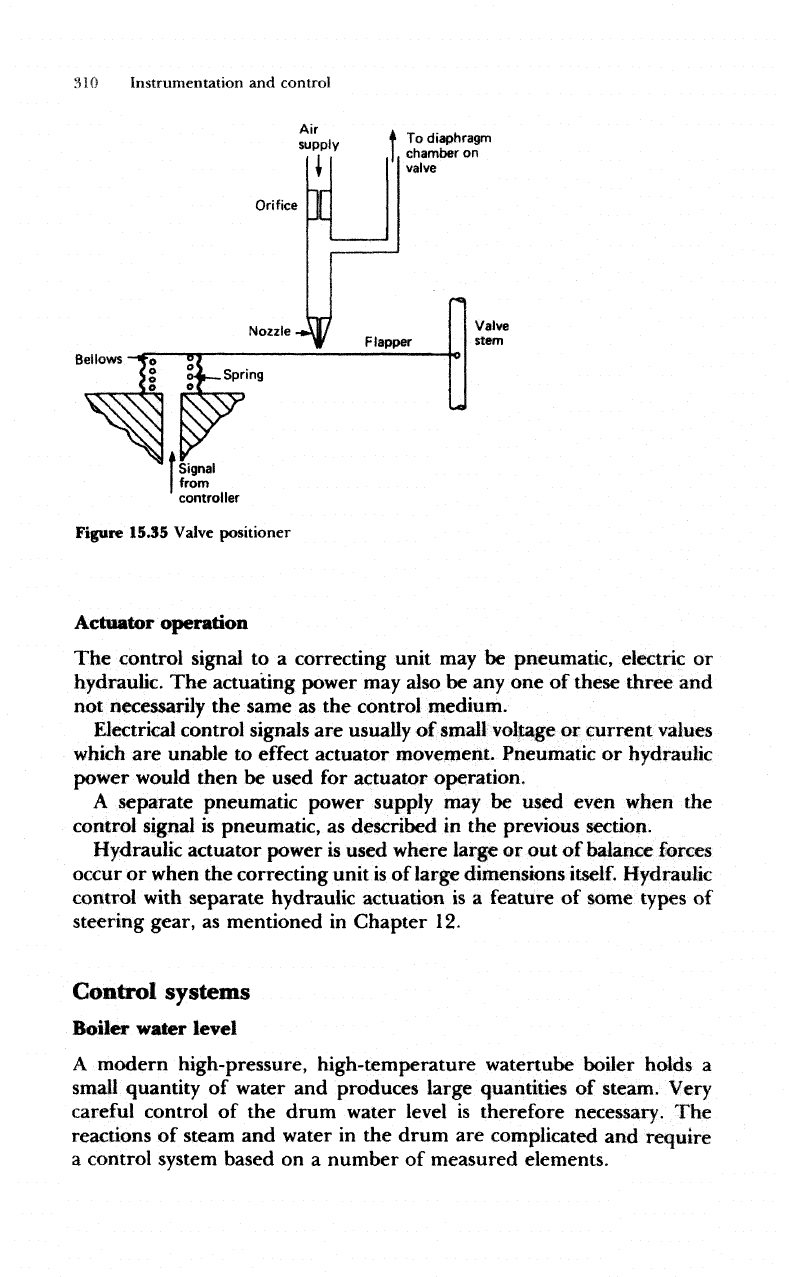
310
Instrumentation
and
control
Air
supply
Orifice
Nozzle
To
diaphragm
chamber
on
valve
Flapper
Bellows
o-u—Spring
Valve
stem
I
Signal
j
from
controller
Figure
15.35
Valve
positioner
Actuator
operation
The
control
signal
to a
correcting unit
may be
pneumatic, electric
or
hydraulic.
The
actuating
power
may
also
be any one of
these
three
and
not
necessarily
the
same
as the
control
medium.
Electrical control signals
are
usually
of
small voltage
or
current values
which
are
unable
to
effect
actuator
movement.
Pneumatic
or
hydraulic
power would then
be
used
for
actuator operation.
A
separate
pneumatic power supply
may be
used even
when
the
control signal
is
pneumatic,
as
described
in the
previous section.
Hydraulic
actuator power
is
used where large
or out of
balance forces
occur
or
when
the
correcting unit
is of
large dimensions itself. Hydraulic
control
with
separate
hydraulic actuation
is a
feature
of
some types
of
steering gear,
as
mentioned
in
Chapter
12.
Control
systems
Boiler
water level
A
modern high-pressure, high-temperature
watertube
boiler holds
a
small
quantity
of
water
and
produces large quantities
of
steam.
Very
careful
control
of the
drum water level
is
therefore necessary.
The
reactions
of
steam
and
water
in the
drum
are
complicated
and
require
a
control
system
based
on a
number
of
measured elements.
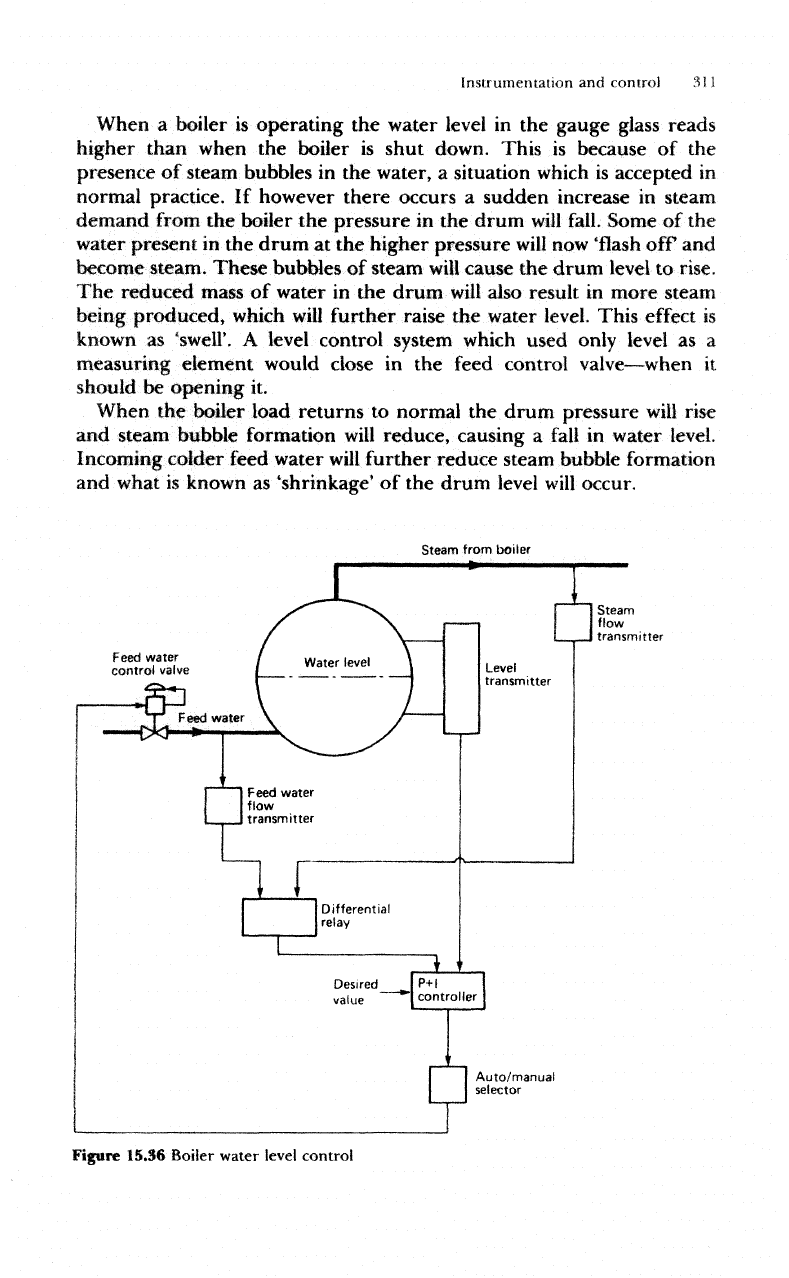
Instrumentation
and
control
311
When
a
boiler
is
operating
the
water
level
in the
gauge glass reads
higher than when
the
boiler
is
shut down. This
is
because
of the
presence
of
steam bubbles
in the
water,
a
situation
which
is
accepted
in
normal
practice.
If
however there occurs
a
sudden increase
in
steam
demand
from
the
boiler
the
pressure
in the
drum
will
fail.
Some
of the
water
present
in the
drum
at the
higher pressure
will
now
'flash
off and
become
steam.
These
bubbles
of
steam
will
cause
the
drum
level
to
rise.
The
reduced mass
of
water
in the
drum
will
also result
in
more steam
being produced,
which
will
further raise
the
water
level.
This
effect
is
known
as
"swell',
A
level control system
which
used
only
level
as a
measuring element would close
in the
feed
control
valve—when
it
should
be
opening
it.
When
the
boiler load returns
to
normal
the
drum pressure
will
rise
and
steam bubble formation
will
reduce, causing
a
fall
in
water level.
Incoming colder feed water
will
further reduce steam bubble formation
and
what
is
known
as
'shrinkage'
of the
drum
level
will
occur.
Steam
from
boiler
Auto/manual
selector
Figure
15.56
Boiler
water
level
control
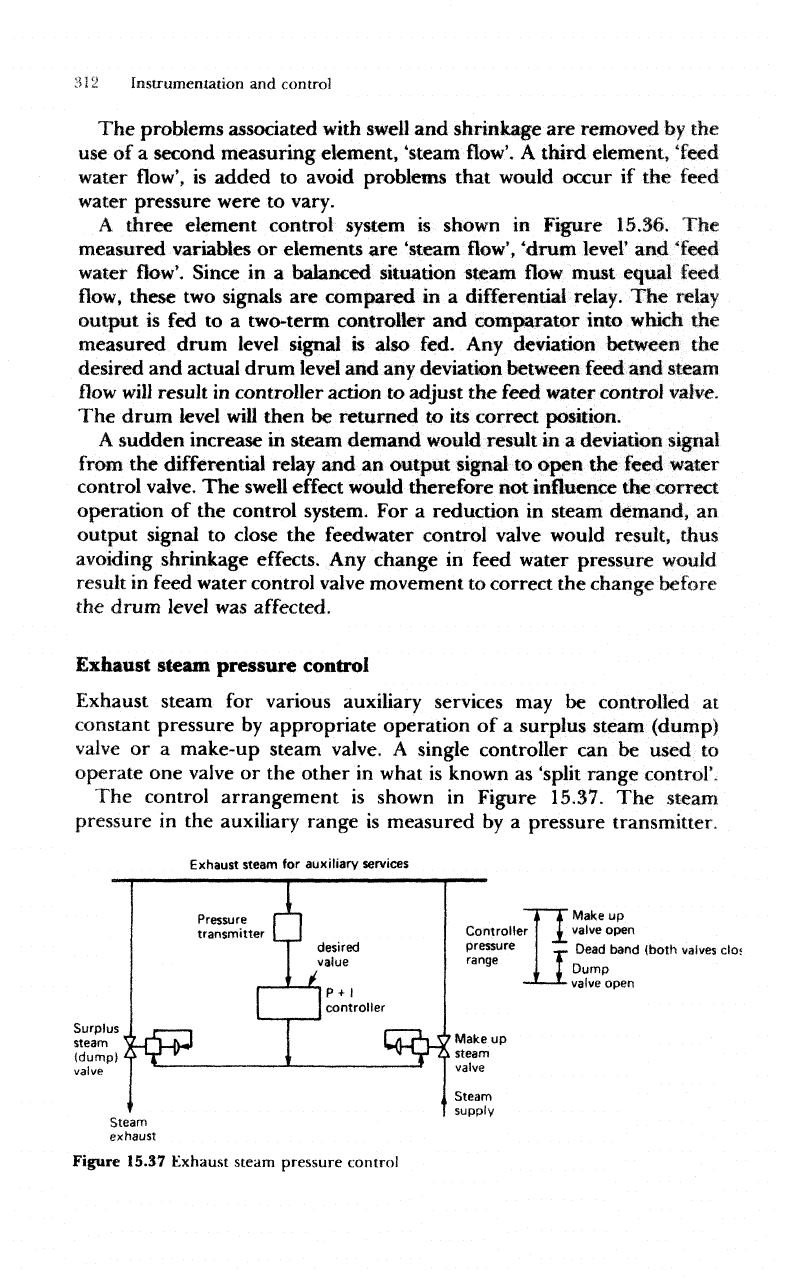
312
Instrumentation
and
control
The
problems
associated
with
swell
and
shrinkage
are
removed
by the
use
of a
second measuring element,
'steam
flow'. A
third element,
'feed
water
flow', is
added
to
avoid problems that would occur
if the
feed
water
pressure were
to
vary.
A
three element control system
is
shown
in
Figure
15.$6.
The
measured
variables
or
elements
are
'steam
flow',
'drum
level*
and
'feed
water
flow*.
Since
in a
balanced
situation
steam
flow
must equal
feed
flow,
these
two
signals
are
compared
in a
differential
relay.
The
relay
output
is fed to a
two-term controller
and
comparator into which
the
measured
drum level signal
is
also fed.
Any
deviation between
the
desired
and
actual drum
level
and any
deviation
between
feed
and
steam
flow
will
result
in
controller action
to
adjust
the
feed water control valve.
The
drum level
will
then
be
returned
to its
correct
position.
A
sudden increase
in
steam demand would result
in a
deviation signal
from
the
differential relay
and an
output signal
to
open
the
feed water
control valve.
The
swell
effect
would therefore
not
influence
the
correct
operation
of the
control system.
For a
reduction
in
steam demand,
an
output signal
to
close
the
feedwater control
valve
would
result, thus
avoiding
shrinkage
effects.
Any
change
in
feed water pressure
would
result
in
feed
water control
valve
movement
to
correct
the
change before
the
drum level
was
affected.
Exhaust
steam
pressure
control
Exhaust
steam
for
various auxiliary services
may be
controlled
at
constant
pressure
by
appropriate operation
of a
surplus
steam
(dump)
valve
or a
make-up
steam
valve,
A
single controller
can be
used
to
operate
one
valve
or the
other
in
what
is
known
as
'split
range
control*.
The
control arrangement
is
shown
in
Figure 15.37.
The
steam
pressure
in the
auxiliary
range
is
measured
by a
pressure transmitter.
Exhaust
steam
for
auxiliary
services
Surplus
steam
\
JL
Pressure
I
transmitter
| |
J
desired
value
P +
1
controller
•
i
*
>
Lrt-U
LurHA
Controller
pressure
range
n
ii
'
Make
up
(dump)
A
Y
"^
i
'*Y
21
steam
valve
"
Make
up
valve
open
*
Dead
band
{both
valves
cloj
Dump
valve
open
Steam
exhaust
Steam
supply
Figure
15.37
Exhaust
steam
pressure
control
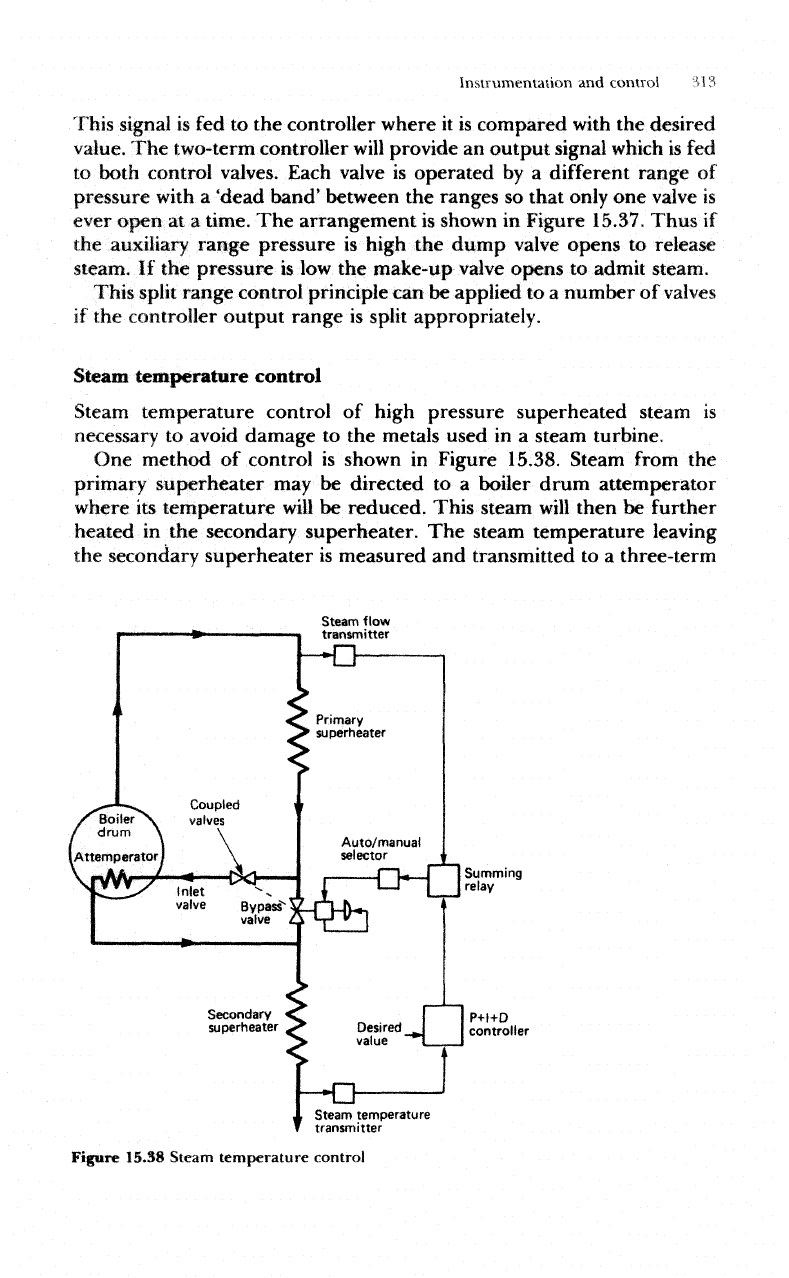
Instrumentation
and
control
313
This signal
is fed to the
controller where
it is
compared
with
the
desired
value.
The
two-term controller
will
provide
an
output signal
which
is fed
to
both
control
valves.
Each
valve
is
operated
by a
different
range
of
pressure
with
a
'dead
band'
between
the
ranges
so
that only
one
valve
is
ever
open
at a
time.
The
arrangement
is
shown
in
Figure 15.37. Thus
if
the
auxiliary range pressure
is
high
the
dump
valve
opens
to
release
steam.
If the
pressure
is low the
make-up
valve
opens
to
admit steam.
This split range control principle
can be
applied
to a
number
of
valves
if
the
controller output range
is
split appropriately.
Steam
temperature control
of
high pressure superheated steam
is
necessary
to
avoid damage
to the
metals used
in a
steam turbine.
One
method
of
control
is
shown
in
Figure 15.38. Steam
from
the
primary
superheater
may be
directed
to a
boiler drum attemperator
where
its
temperature
will
be
reduced.
This
steam
will
then
be
further
heated
in the
secondary
superheater.
The
steam temperature leaving
the
secondary superheater
is
measured
and
transmitted
to a
three-term
Steam
temperature
transmitter
Figure
15.38 Steam
temperature
control
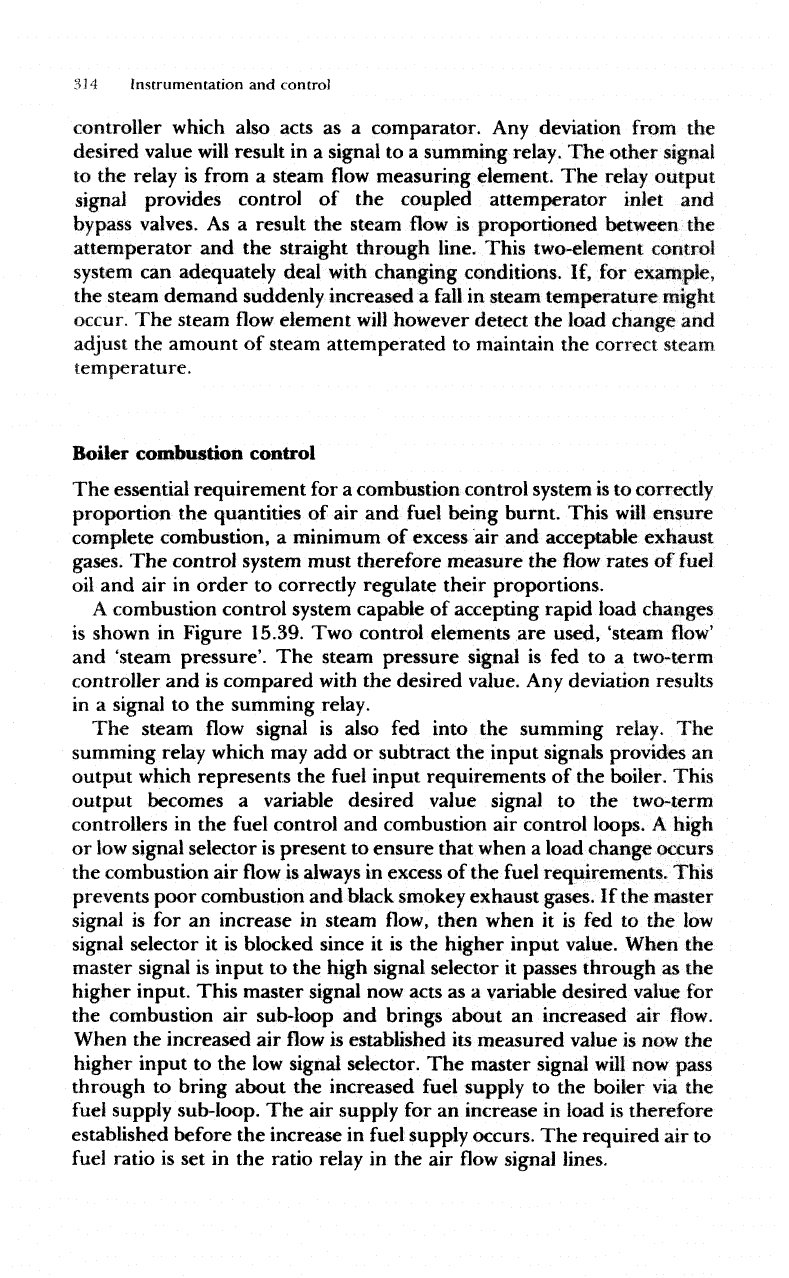
314
Instrumentation
and
control
controller
which
also acts
as a
comparator.
Any
deviation
from
the
desired
value
will
result
in a
signal
to a
summing relay.
The
other
signal
to the
relay
is
from
a
steam
flow
measuring
element.
The
relay
output
signal
provides
control
of the
coupled
attemperator
inlet
and
bypass valves.
As a
result
the
steam
flow is
proportioned
between
the
attemperator
and the
straight through
line.
This
two-element control
system
can
adequately deal
with
changing conditions.
If, for
example,
the
steam demand suddenly increased
a
fall
in
steam temperature might
occur.
The
steam
flow
element
will
however
detect
the
load
change
and
adjust
the
amount
of
steam attemperated
to
maintain
the
correct
steam
temperature.
Boiler
combustion
control
The
essential requirement
for a
combustion control system
is to
correctly
proportion
the
quantities
of air and
fuel
being burnt.
This
will
ensure
complete combustion,
a
minimum
of
excess
air and
acceptable exhaust
gases.
The
control
system must therefore
measure
the flow
rates
of
fuel
oil
and air in
order
to
correctly regulate their proportions.
A
combustion control system capable
of
accepting rapid load
changes
is
shown
in
Figure 15.39.
Two
control elements
are
used,
'steam
flow'
and
'steam
pressure'.
The
steam
pressure
signal
is fed to a
two-term
controller
and is
compared
with
the
desired
value.
Any
deviation results
in
a
signal
to the
summing relay.
The
steam
flow
signal
is
also
fed
into
the
summing relay.
The
summing
relay
which
may add or
subtract
the
input signals provides
an
output which represents
the
fuel
input requirements
of the
boiler. This
output becomes
a
variable
desired
value signal
to the
two-term
controllers
in the
fuel
control
and
combustion
air
control loops.
A
high
or low
signal selector
is
present
to
ensure that when
a
load change occurs
the
combustion
air flow is
always
in
excess
of the
fuel
requirements.
This
prevents
poor
combustion
and
black
smokey
exhaust gases.
If the
master
signal
is for an
increase
in
steam
flow,
then
when
it is fed to the low
signal
selector
it is
blocked since
it is the
higher input value. When
the
master
signal
is
input
to the
high signal selector
it
passes through
as the
higher input.
This
master signal
now
acts
as a
variable
desired
value
for
the
combustion
air
sub-loop
and
brings about
an
increased
air flow.
When
the
increased
air flow is
established
its
measured
value
is now the
higher input
to the low
signal selector.
The
master signal
will
now
pass
through
to
bring about
the
increased
fuel
supply
to the
boiler
via the
fuel
supply sub-loop.
The air
supply
for an
increase
in
load
is
therefore
established before
the
increase
in
fuel
supply
occurs.
The
required
air to
fuel
ratio
is set in the
ratio relay
in the air flow
signal lines.

Steam
from
boiler
Instrumentation
and
control
315
Combustion
air to
boiler
—IX}
Fuel
oil
supply
to
boiler
Figure
15.39
Boiler
combustion
control
Cooling
water temperature control
Accurate
control
of
diesel
engine
cooling water temperature
is a
requirement
for
efficient
operation.
This
can be
achieved
by a
single
controller under steady load conditions,
but
because
of the
fluctuating
situation
during manoeuvring
a
more complex
system
is
required.
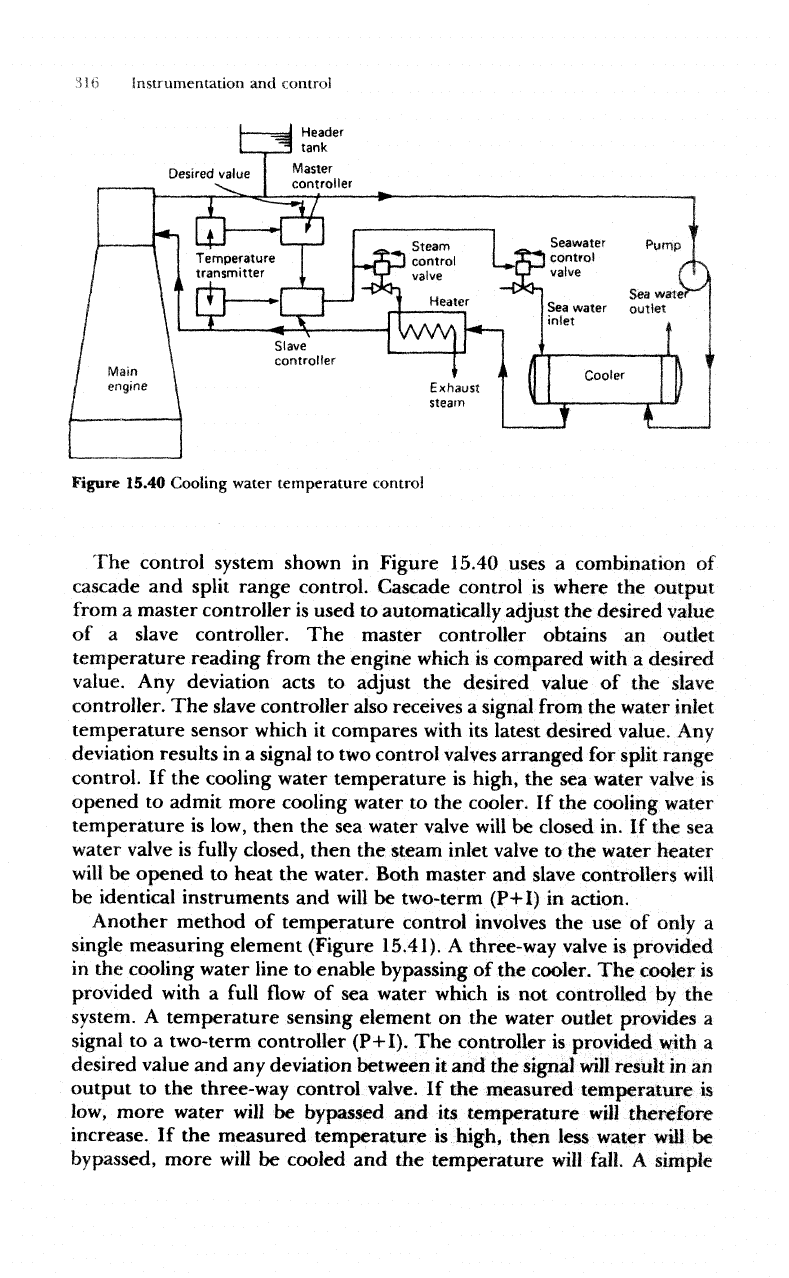
Instrumentation
and
control
Desired
value
Main
engine
Temperature
transmitter
t
JL
Slave
controller
Seawater
Pump
control
valve
Sea
water""""'^
Sea
water
outlet
inlet
Cooler
Figure 15.40 Cooling
water
temperature control
The
control system shown
in
Figure 15.40 uses
a
combination
of
cascade
and
split
range control. Cascade control
is
where
the
output
from
a
master controller
is
used
to
automatically adjust
the
desired
value
of
a
slave controller.
The
master controller obtains
an
outlet
temperature
reading
from
the
engine which
is
compared
with
a
desired
value.
Any
deviation acts
to
adjust
the
desired value
of the
slave
controller.
The
slave
controller
also receives
a
signal
from
the
water inlet
temperature sensor
which
it
compares
with
its
latest desired value.
Any
deviation
results
in a
signal
to two
control
valves
arranged
for
split range
control.
If the
cooling water temperature
is
high,
the sea
water
valve
is
opened
to
admit more cooling water
to the
cooler.
If the
cooling
water
temperature
is
low, then
the sea
water
valve
will
be
closed
in. If the sea
water
valve
is
fully
closed, then
the
steam inlet
valve
to the
water heater
will
be
opened
to
heat
the
water. Both master
and
slave
controllers
will
be
identical instruments
and
will
be
two-term (P+I)
in
action.
Another
method
of
temperature control involves
the use of
only
a
single
measuring element (Figure 15.41).
A
three-way
valve
is
provided
in
the
cooling water line
to
enable bypassing
of the
cooler.
The
cooler
is
provided
with
a
full
flow
of sea
water
which
is not
controlled
by the
system.
A
temperature sensing element
on the
water
outlet
provides
a
signal
to a
two-term controller (P+I).
The
controller
is
provided
with
a
desired value
and any
deviation between
it and the
signal
will
result
in an
output
to the
three-way control valve.
If the
measured
temperature
is
low,
more water
will
be
bypassed
and its
temperature
will
therefore
increase.
If the
measured
temperature
is
high, then less water
will
be
bypassed, more
will
be
cooled
and the
temperature
will
fall
A
simple
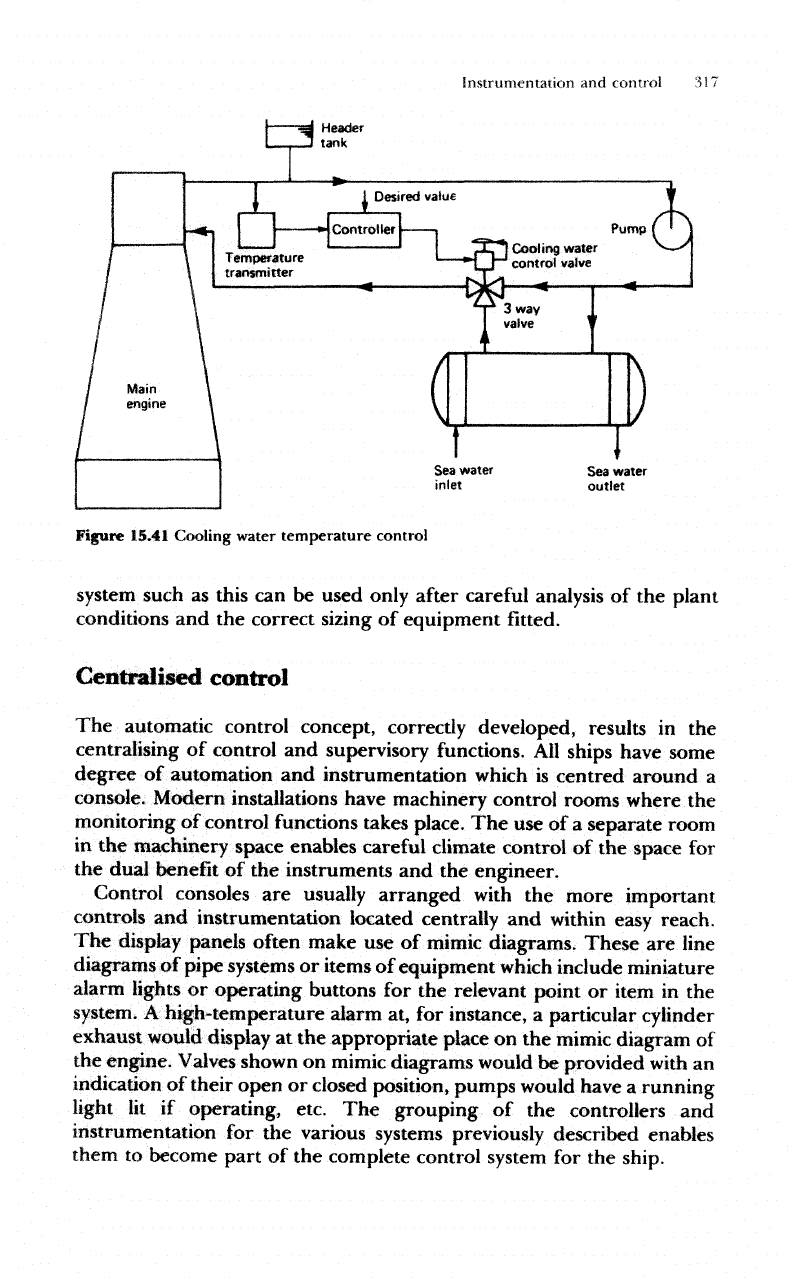
Instrumentation
and
control
317
Figure 15.41 Cooling water temperature control
system
such
as
this
can be
used only after
careful
analysis
of the
plant
conditions
and the
correct
sizing
of
equipment
fitted.
Centralised
control
The
automatic control concept, correctly developed, results
in the
centralising
of
control
and
supervisory functions.
All
ships have some
degree
of
automation
and
instrumentation
which
is
centred
around
a
console.
Modern installations have machinery control rooms where
the
monitoring
of
control
functions
takes place.
The use of a
separate room
in
the
machinery
space
enables careful climate control
of the
space
for
the
dual benefit
of the
instruments
and the
engineer.
Control consoles
are
usually
arranged
with
the
more important
controls
and
instrumentation located centrally
and
within
easy reach.
The
display panels often make
use of
mimic diagrams.
These
are
line
diagrams
of
pipe systems
or
items
of
equipment
which
include miniature
alarm
lights
or
operating buttons
for the
relevant point
or
item
in the
system.
A
high-temperature alarm
at, for
instance,
a
particular cylinder
exhaust
would
display
at the
appropriate
place
on the
mimic diagram
of
the
engine.
Valves
shown
on
mimic diagrams would
be
provided
with
an
indication
of
their open
or
closed position, pumps would have
a
running
light
lit if
operating, etc.
The
grouping
of the
controllers
and
instrumentation
for the
various systems previously described enables
them
to
become part
of the
complete control
system
for the
ship.
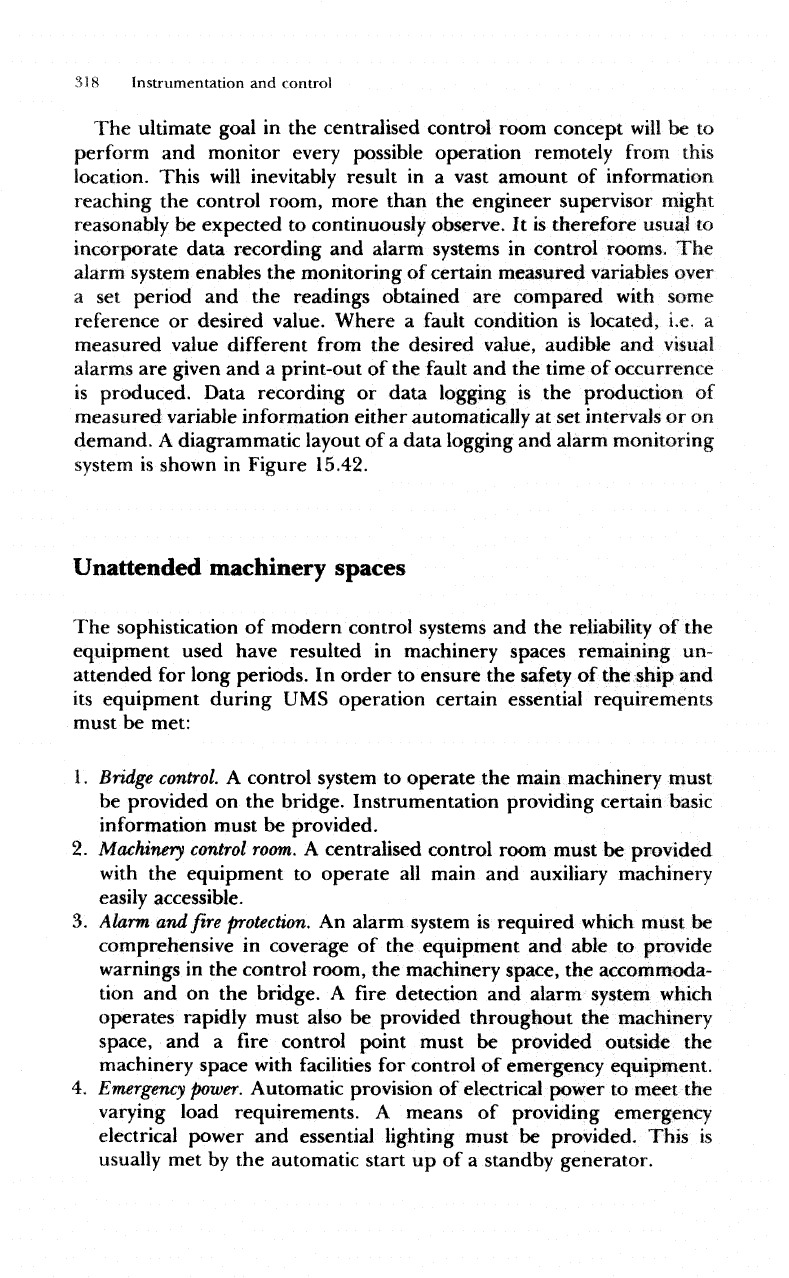
318
Instrumentation
and
control
The
ultimate goal
in the
centralised control room concept
will
be to
perform
and
monitor every
possible
operation remotely from this
location.
This
will
inevitably
result
in a
vast
amount
of
information
reaching
the
control room, more than
the
engineer supervisor might
reasonably
be
expected
to
continuously
observe.
It is
therefore usual
to
incorporate data recording
and
alarm systems
in
control rooms.
The
alarm
system enables
the
monitoring
of
certain measured variables over
a
set
period
and the
readings obtained
are
compared with some
reference
or
desired value. Where
a
fault
condition
is
located,
i.e.
a
measured
value
different
from
the
desired value, audible
and
visual
alarms
are
given
and a
print-out
of the
fault
and the
time
of
occurrence
is
produced.
Data
recording
or
data logging
is the
production
of
measured variable information
either
automatically
at set
intervals
or on
demand.
A
diagrammatic layout
of a
data logging
and
alarm monitoring
system
is
shown
in
Figure
15,42.
Unattended
machinery
spaces
The
sophistication
of
modern control systems
and the
reliability
of the
equipment
used have resulted
in
machinery spaces remaining
un-
attended
for
long periods.
In
order
to
ensure
the
safety
of the
ship
and
its
equipment during
UMS
operation certain essential requirements
must
be
met:
1.
Bridge
control.
A
control system
to
operate
the
main machinery must
be
provided
on the
bridge. Instrumentation providing certain basic
information
must
be
provided.
2.
Machinery
control
room.
A
centralised control room must
be
provided
with
the
equipment
to
operate
all
main
and
auxiliary machinery
easily
accessible.
3.
Alarm
and
fire
protection.
An
alarm
system
is
required
which
must
be
comprehensive
in
coverage
of the
equipment
and
able
to
provide
warnings
in the
control room,
the
machinery space,
the
accommoda-
tion
and on the
bridge.
A
fire
detection
and
alarm system
which
operates rapidly must also
be
provided throughout
the
machinery
space,
and a fire
control point must
be
provided outside
the
machinery
space
with
facilities
for
control
of
emergency equipment.
4.
Emergency
power.
Automatic provision
of
electrical power
to
meet
the
varying
load requirements.
A
means
of
providing emergency
electrical
power
and
essential lighting must
be
provided. This
is
usually
met by the
automatic
start
up of a
standby generator.
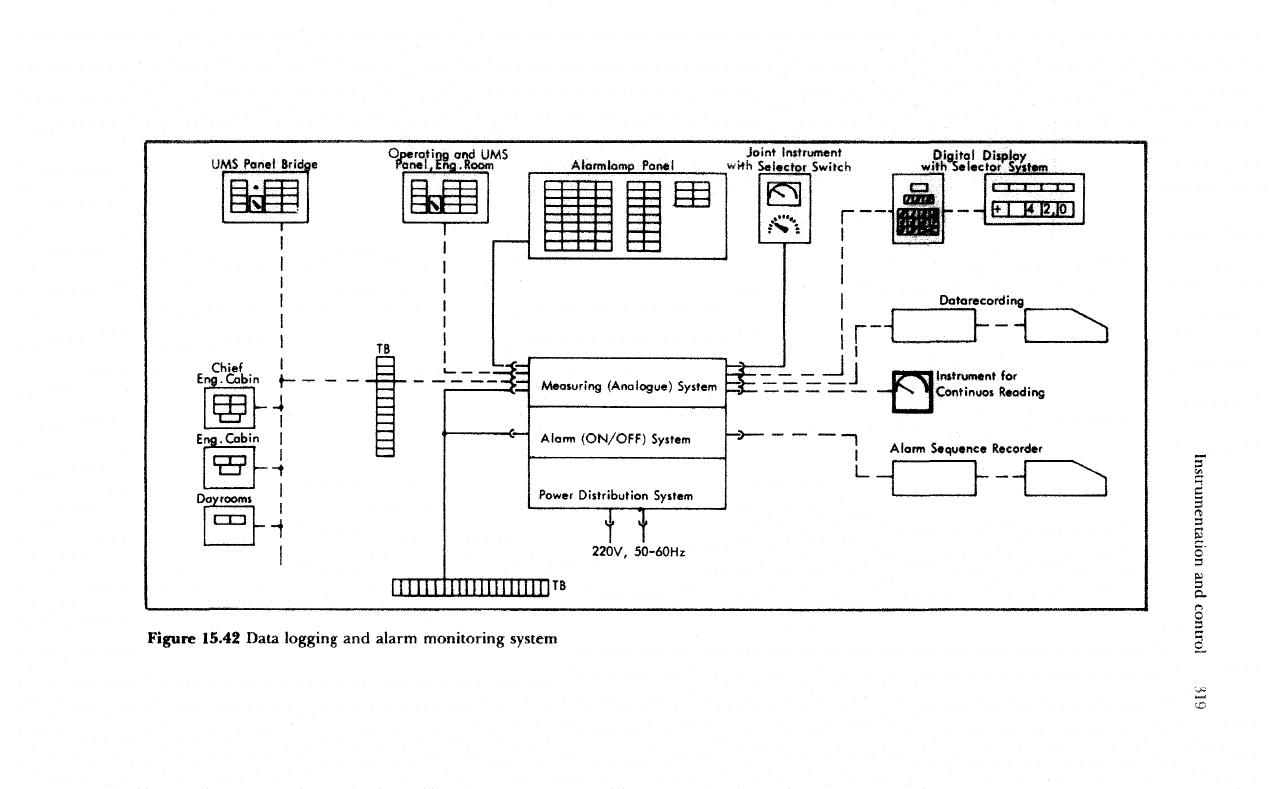
Instrumentation
and
control
319
